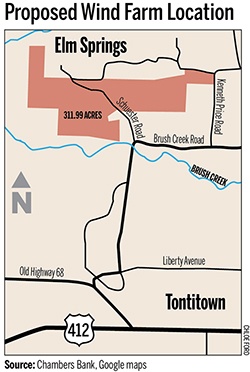Texas Firm Planning 80-Megawatt Wind Farm Near Elm Springs
by January 19, 2015 12:00 am 251 views

A Texas-based energy company is in the planning phase of building a 311-acre, 80-megawatt wind farm in Washington County, which would be the first in Arkansas.
Dragonfly Industries International LLC of Frisco is expected to submit a large-scale development plan at some point to the Elm Springs Planning Commission. The potential site is near Elm Springs at the westernmost intersection of Brush Creek and Kenneth Price roads, and at full-stage, the 80-megawatt farm could power more than 26,000 homes.
“We have projects in the United Kingdom and in Europe, and Arkansas would be our first in the U.S.,” said Jody Davis, Dragonfly’s CEO. “We wanted to introduce Arkansas to renewable energy. Northwest Arkansas is very underestimated in its ability to produce wind power. We’re excited about coming to the state.”
Dragonfly representative Cody Fell has already appeared at one planning commission meeting and one meeting of the Elm Springs City Council to pitch the project.
Dragonfly is negotiating the purchase of a multi-piece, 311-acre tract just north of Brush Creek Road from Kenneth Price on the east and past Schuester Road on the west. The property is a foreclosure owned by Chambers Bank of Danville. Though Dragonfly’s offer amount is unknown, a real estate listing from last year shows the acreage with a list price of $2.3 million.
According to the Dec. 15 City Council minutes, Dragonfly builds wind turbines, rather than windmills, and it is the first technology of its kind in the nation and the world.
According to minutes from the meeting, the wind turbines, which resemble those hanging from the wings of jetliners, would be mounted on 100-foot poles that would be placed at 1-acre intervals.
The turbines would be raised and lowered using computers and, according to minutes from the Dec. 15 meeting, the noise from the turbines would be “less than the sound of a blow dryer.”
According to the City Council minutes, the first phase of construction would cost $100 million, with as many as 40 poles installed.
According to Google Maps, the proposed location is just outside the city limits of Elm Springs in unincorporated Washington County. According to the City Council minutes, Dragonfly “want[s] to be in the city,” which would require an annexation of the acreage where Dragonfly wants to build, and improvements to Kenneth Price Road would also be needed.
Dragonfly is also hoping to purchase property along Interstate 49 for corporate offices, according to the City Council minutes. According to Dec. 8 Planning Commission minutes, Dragonfly wants to be a “power purchase provider,” meaning Dragonfly would sell its energy to utility companies.
Dragonfly was formed in September 2014 in Plano, Texas, by Phillip Ridings, according to the Texas Secretary of State. According to the company’s webpage, Dragonfly has offices in the United States and Poland, an affiliate in the United Kingdom, and a Houston-based representative for Africa.
The Dragonfly technology uses a turbine that looks like a jet engine as opposed to the giant, three-blade propeller normally associated with wind power. According to Dragonfly’s webpage, the technology is patent-pending.
While Arkansas produces no wind power, four of its neighbors do, according to the American Wind Energy Association’s market report for the 3Q 2014 — Tennessee, Missouri, Texas and Oklahoma.
Dragonfly’s proposed arrival in Northwest Arkansas comes at a pivotal moment for wind energy. The second quarter of 2014 witnessed an all-time high in wind power under construction — 14,600 megawatts — and at a total capacity of 62,300 megawatts nationwide, wind power in the United States is as high as it’s ever been.
The World Wind Energy Association, in its 2014 World Wind Resource Assessment Report, said wind energy has finally arrived.
“About 15 years back, wind turbines were a fringe technology, not taken seriously and often seen as [a] mere nuisance to the conventional power systems,” the report reads. “Today, however, with more than 337 GW of wind power generation capacity installed in more than 100 countries meeting more than 4 percent of the electricity requirements of the world, the status of the technology has changed dramatically. It’s a mainstream technology now.”
